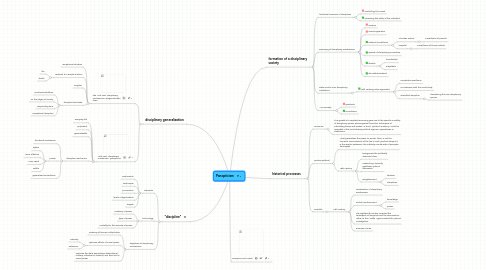
1. disciplinary generalization
1.1. late 17th cent. disciplinary mechanisms: plague-stricken town
1.1.1. exceptional situation
1.1.2. reduced to a simple dualism
1.1.2.1. life
1.1.2.2. death
1.1.3. singular
1.1.4. discipline-blockade
1.1.4.1. enclosed institution
1.1.4.2. on the edges of society
1.1.4.3. suspending time
1.1.4.4. exceptional discipline
1.2. 19th cent. disciplinary mechanism: panopticon
1.2.1. everyday life
1.2.2. polyvalent
1.2.3. generalizable
1.2.4. discipline-mechanism
1.2.4.1. functional mechanism
1.2.4.2. power
1.2.4.2.1. lighter
1.2.4.2.2. more effective
1.2.4.2.3. more rapid
1.2.4.2.4. subtle
1.2.4.3. generalized surveillance
2. Discipline and Punish
3. formation of a disciplinary society
3.1. functional inversion of disciplines
3.1.1. controlling the crowd
3.1.2. increasing the utility of the individual
3.2. swarming of disciplinary mechanisms
3.2.1. massive
3.2.2. closed apparatus
3.2.3. external surveillance
3.2.3.1. Christian School
3.2.3.1.1. surveillance of parents
3.2.3.2. hospital
3.2.3.2.1. surveillance of those outside
3.2.4. spread of disciplinary procedures
3.2.5. flexible
3.2.5.1. transferable
3.2.5.2. adaptable
3.2.6. de-institutionalized
3.3. state control over disciplinary institutions
3.3.1. 18th century police apparatus
3.3.1.1. complete surveillance
3.3.1.2. co-extensive with the social body
3.3.1.3. interstitial discipline
3.3.1.3.1. disciplining the non-disciplinary spaces
3.4. "our society"
3.4.1. spectacle
3.4.2. surveillance
4. "discipline"
4.1. elements
4.1.1. instruments
4.1.2. techniques
4.1.3. procedures
4.1.4. levels of applications
4.1.5. targets
4.2. technology
4.2.1. anatomy of power
4.2.2. type of power
4.2.3. modality for the exercise of power
4.3. objectives of disciplinary mechanisms
4.3.1. ordering of human multiplicities
4.3.2. optimize effects of social power
4.3.2.1. intensity
4.3.2.2. extension
4.3.3. optimize the state apparatuses (educational, military, industrial or medical) and their link to social power
5. historical processes
5.1. economic
5.1.1. The growth of a capitalist economy gave rise to the specific modality of disciplinary power whose general formulas, techniques of submitting forces and bodies, in short, 'political anatomy', could be operated in the most diverse political regimes, apparatuses or institutions.
5.2. juridico-political
5.2.1. What generalizes the power to punish, then, is not the universal consciousness of the law in each juridical subject; it is the regular extension, the infinitely minute web of panoptic techniques.
5.2.2. 18th century
5.2.2.1. bourgeoisie the politically dominant class
5.2.2.2. masked by a formally egalitarian judicial framework
5.2.2.3. Enlightenment
5.2.2.3.1. liberties
5.2.2.3.2. disciplines
5.3. scientific
5.3.1. 18th century
5.3.1.1. combination of disciplinary mechanisms
5.3.1.2. mutual reinforcement
5.3.1.2.1. knowledge
5.3.1.2.2. power
5.3.1.3. The eighteenth century invented the techniques of discipline and the examination, rather as the Middle Ages invented the judicial investigation.
5.3.1.4. sciences of man

